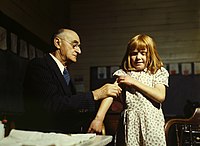
Photo from wikipedia
BackgroundEfforts in search of lasting malaria vaccine have led to the development of transgenic rodent malaria parasites. As a result, wild type Plasmodium berghei ANKA (WTPbA) has recently been transformed… Click to show full abstract
BackgroundEfforts in search of lasting malaria vaccine have led to the development of transgenic rodent malaria parasites. As a result, wild type Plasmodium berghei ANKA (WTPbA) has recently been transformed to express mouse interferon gamma (mIFN-γ). The immunomodulatory effect of this transgenic parasite on WTPbA infection has been demonstrated. However, the protective immune responses after repeated immunization with soluble lysate of this parasite has not been investigated.MethodsSoluble lysate of transgenic PbA (TPbA) was prepared and concentration of IFN-γ in lysate determined by ELISA. Four groups of 20 BALB/c mice each (two treatment groups and two control groups) were setup. Treatment Groups 1 and 2 were primed (at day 0) with lysate of TPbA containing 75 pg/ml IFN-γ and live TPbA parasites respectively. Infection in Group 2 mice was cured with Coartem™ at 450 mg/kg for 3 days. At day 14 post-priming, both groups were boosted twice at day 14 and day 28 with lysate of TPbA containing 75 pg/ml IFN-γ and 35 pg/ml IFN-γ respectively. Blood and spleen samples were collected at day 0, day 14, day 21 and day 28 for preparation of serum and cell cultures respectively. Serum IgG and cytokines (TNF-α and IFN-γ) levels in culture supernatant were measred by ELISA.Survivorship and parasitemia were daily monitored for 21 days. Data were statistically analyzed using ANOVA student’s t test. A p value of <0.05 was considered significant.ResultsAt day 28 post-priming, IFN-γ production in Group 1 was tenfold higher than in RBC control group (p = 0.070) There was significant difference in IFN-γ production among the groups at day 28 (p < 0.0001). TNF-α production in Group 1 mice increased fourfold in Group 2 mice from day 14 to day 28 post-immunization (p = 0.0005). There was no significant effect on serum IgG production. Mice in treatment groups survived 5 to 4 days longer compared to non-immunized group.ConclusionThe study has demonstrated that, repeated immunization with soluble lysate of TPbA induces Th 1 response leading to increased IFN-γ and TNF-γ production.
Journal Title: Tropical Diseases, Travel Medicine and Vaccines
Year Published: 2017
Link to full text (if available)
Share on Social Media: Sign Up to like & get
recommendations!